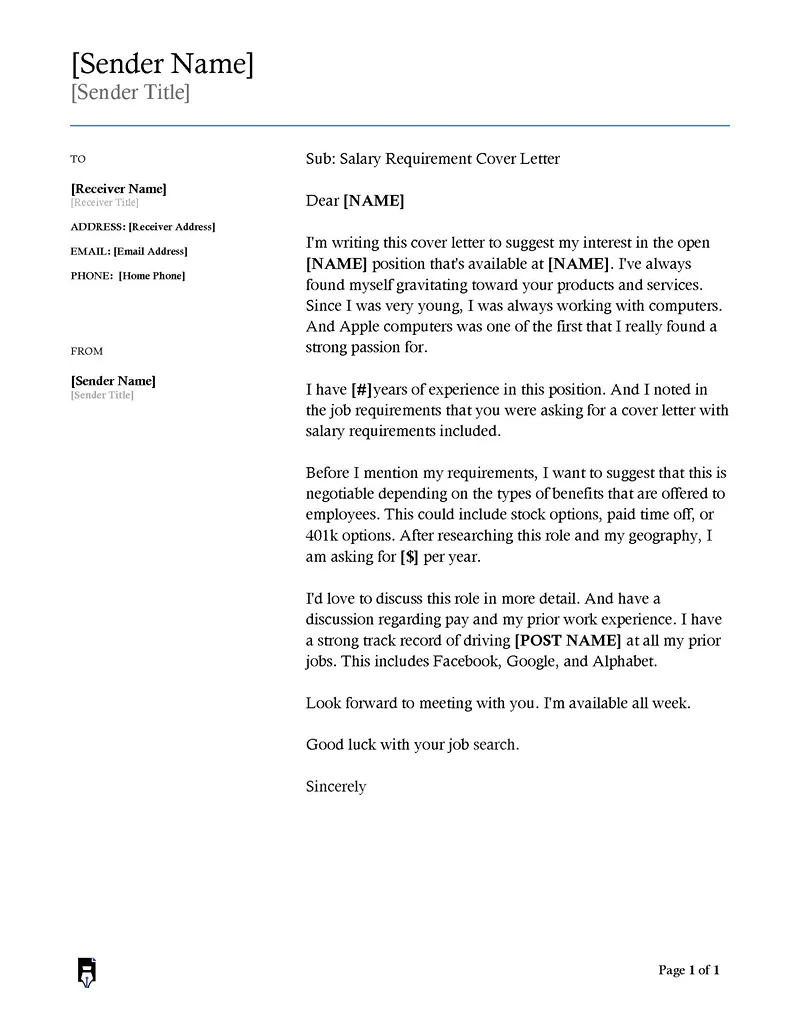What is a Salary Requirements Cover Letter
A salary requirements cover letter is a crucial document you send alongside your resume when applying for a job. Its primary purpose is to communicate your salary expectations to a potential employer. While not always mandatory, including this information upfront demonstrates that you’ve considered your worth and what you’re seeking. This proactive approach can save time for both you and the hiring manager. It helps ensure alignment on compensation early in the hiring process. The letter offers a formal space to explain your desired salary, providing context to your application. It’s a strategic move in your job search, showcasing professionalism and preparedness. Think of it as a pre-emptive strike, setting the stage for salary discussions.
Why You Need a Salary Requirements Cover Letter
Including a salary requirements cover letter can significantly benefit your job application. It shows you’ve researched the role and the industry standards for compensation. Demonstrating this level of preparation showcases your seriousness and interest in the position. It opens the door for early salary discussions, potentially saving time if your expectations don’t align with the employer’s budget. Employers value candidates who are clear about their expectations. A well-crafted cover letter signals your understanding of your value, making you a more attractive candidate. Furthermore, it can help you stand out from other applicants. Many candidates might avoid mentioning salary, so being proactive can make you memorable. It communicates professionalism and helps you navigate the application process effectively.
How to Research Salary Expectations
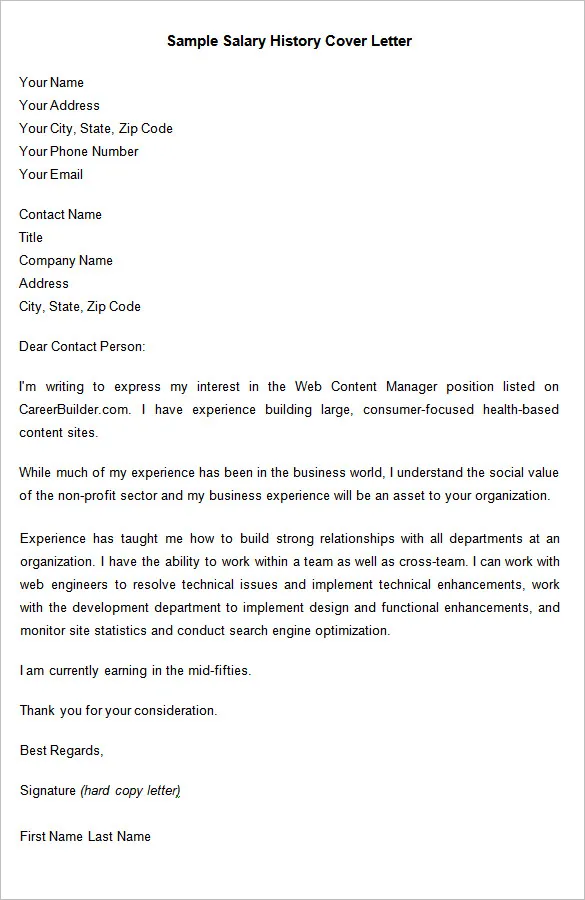
Thorough research is essential to determining your salary expectations. Start by researching the job title and industry you are applying for. Several online resources provide salary data, including industry reports, and company review sites. These resources can offer salary ranges based on location, experience level, and specific skills required. Next, consider your experience, skills, and qualifications. Evaluate your achievements and how they align with the job requirements. This helps you understand the value you bring. It’s vital to understand market standards. Don’t underestimate the importance of knowing your worth. Your research should provide data and a clear understanding of how much you deserve. Understanding this allows you to set realistic expectations.
Tips for Researching Salary Ranges
When researching salary ranges, use multiple resources to get a comprehensive view. Look at salary data from different sources like Glassdoor, Salary.com, and Payscale. Each source may use slightly different methodologies, so comparing them offers a broader understanding. Consider the geographic location of the job. Salaries often vary significantly depending on the cost of living and the demand for the specific role. Also, factor in the company’s size and reputation. Larger, more established companies may offer higher salaries than smaller startups. Don’t forget to account for your experience level and the specific skills. Senior-level positions will pay more than entry-level. Include your skills and education in the equation as well.
Where to Find Salary Data
There are numerous places to find salary data. Professional networking sites can provide some insight. Industry-specific job boards often list salary ranges along with job descriptions. Company review websites can give you a sense of the pay bands. Government resources can offer aggregated salary data. Many recruitment agencies provide salary surveys. When gathering data, cross-reference multiple sources to ensure accuracy and reliability. This helps you form a well-informed opinion on your expected salary. Salary comparison tools are easily accessible, making the process efficient. Look for data specific to your role and location, as these factors greatly influence salary levels. Remember that the more research you do, the more prepared you will be during the negotiation process.
Salary Research Tools
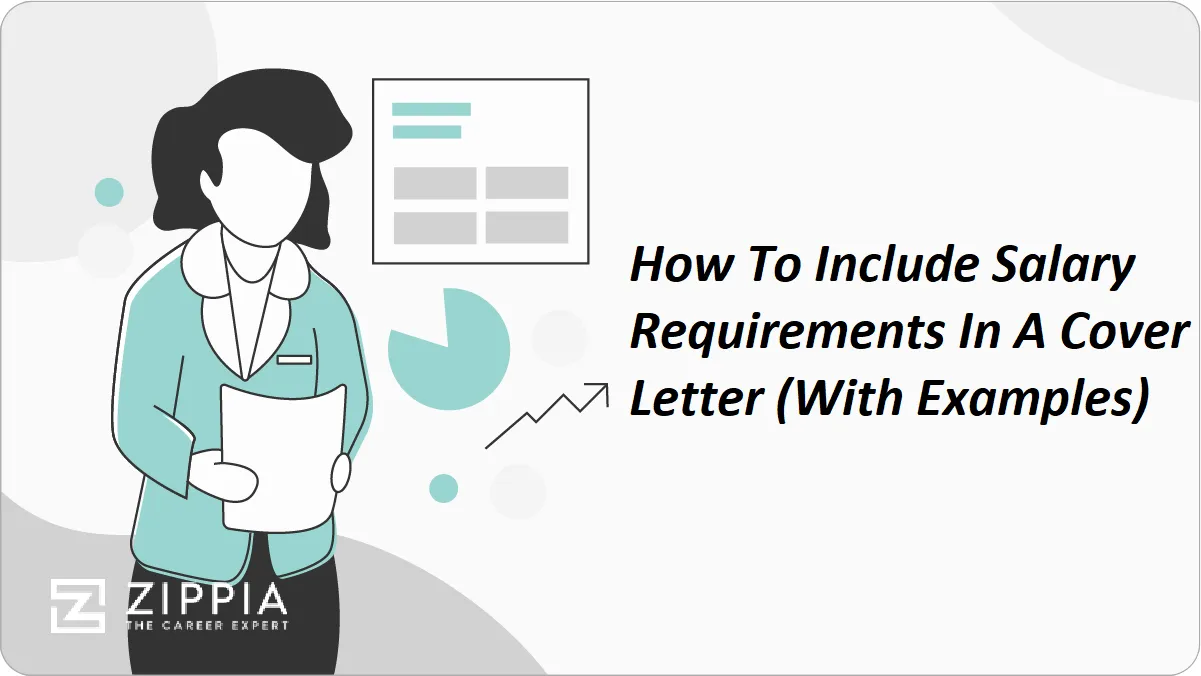
Various online tools can streamline your salary research. Websites like Glassdoor offer salary ranges and insights. LinkedIn can help you research average salaries. Payscale provides detailed salary reports. Salary.com also offers a range of tools and data. These tools often consider multiple factors like experience, skills, and location. Using these resources saves time. They allow you to quickly compare potential salaries across various roles and companies. Some tools even provide personalized salary estimates. Take advantage of these tools to create an informed salary requirement. The data provided by these tools will make your job easier.
Structuring Your Cover Letter for Salary Requirements
Structuring your cover letter strategically ensures you communicate your salary expectations effectively. Begin with your contact information, including your name, address, phone number, and email address. Next, include the date and the recipient’s contact details. The introduction should state the role you’re applying for and where you saw the job posting. In the body, clearly express your interest in the role and briefly highlight your qualifications and experience. State your salary expectations. You can provide a specific number or a salary range. It’s often better to provide a range. Lastly, express your gratitude for their time and consideration, and include a call to action. Proofread your letter before submitting it.
Your Contact Information
Your contact information should be clearly visible at the top of your cover letter. Include your full name, address, phone number, and professional email address. Ensure your email address is professional. This information is crucial, as it allows the hiring manager to quickly reach you. Also, the address indicates where you reside. Keep it concise and easy to read. Double-check that all the information is accurate. This small detail contributes to your overall professionalism. Your contact information is your first impression. Therefore, it must be flawless.
The Introduction
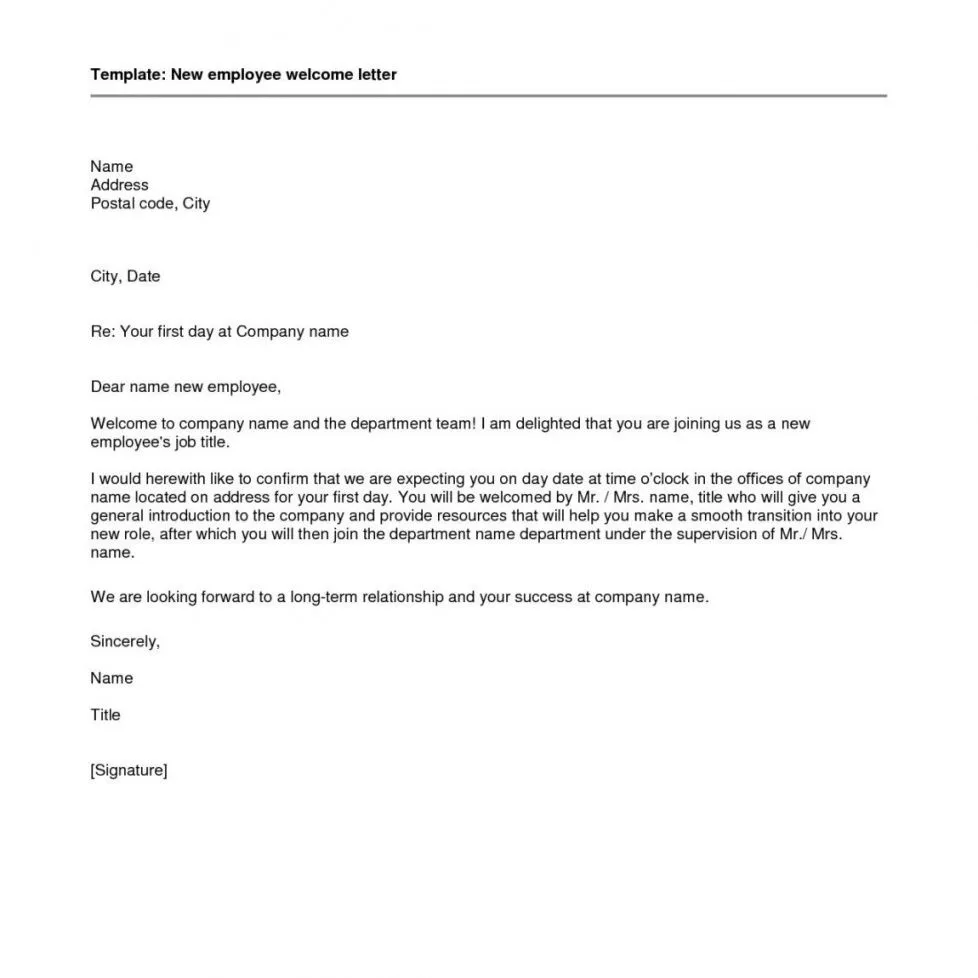
The introduction should immediately capture the reader’s attention. State the specific role you are applying for and how you learned about the position. This provides context. Briefly mention why you are interested in the company and the role. Demonstrating your enthusiasm sets a positive tone. For example, ‘I am writing to express my interest in the Marketing Manager position at XYZ Company, as advertised on LinkedIn.’ This is concise and conveys your intent. The introduction sets the stage for the rest of your cover letter. So, ensure it is engaging and clearly states your purpose.
Expressing Your Interest and Value
Following the introduction, express your interest in the role and company. Highlight why you are a good fit. Briefly mention your relevant skills and experience that align with the job requirements. Focus on how you can contribute to the company’s goals and objectives. Show that you have researched the company. Tailor your statements to align with the job description. Use specific examples of your accomplishments. This is a chance to make a compelling first impression. When showing your value, make sure it is concise. Use a positive and confident tone to convey your value.
Mentioning Your Salary Expectations
This is where you directly address your salary requirements. Be clear, concise, and professional. It is important to strike the right balance between being assertive and flexible. Consider mentioning a salary range. This indicates your understanding of market values. Be realistic and base your expectations on your research. Avoid vague statements such as ‘competitive salary’. Include this section after you have expressed your interest and highlighted your qualifications. Then, you can introduce your expectations. Provide a solid foundation for your requirements. It demonstrates your preparedness.
How to Phrase Your Salary Requirements
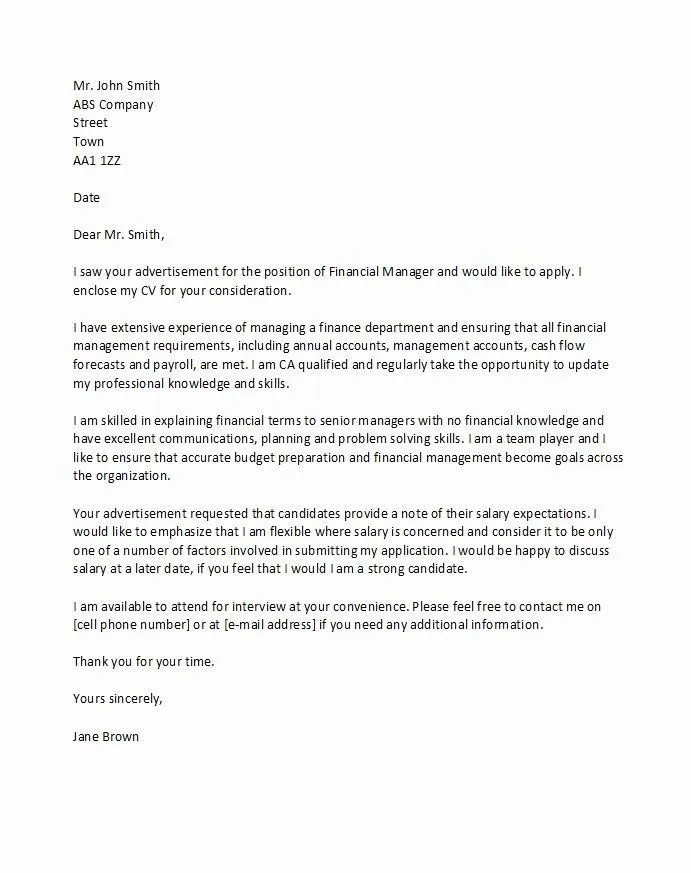
The way you phrase your salary requirements is critical. Use clear and confident language. Instead of saying, ‘I am hoping for a salary of,’ try, ‘I am seeking a salary in the range of…’ This subtle change communicates confidence. If you are providing a specific number, ensure it is based on your research. Avoid being overly demanding or apologetic. Keep your tone professional and positive. Examples of phrases that you can use include: ‘My salary expectations are in the range of $X to $Y,’ or ‘I am targeting a salary of approximately $Z.’ Ensure this aligns with the company’s practices. The way you phrase your requirements shapes the reader’s impression.
Providing a Salary Range
Providing a salary range offers flexibility and shows that you have considered the market. The range should reflect your research and the value you bring. The spread of the range should be realistic. It should not be too wide or narrow. A narrower range shows you know what you’re worth. A wider one is more flexible. Start with your desired salary and slightly increase it for the upper end of the range. This provides room for negotiation. Be prepared to justify your range based on your skills, experience, and the job requirements. Clearly state that the range is negotiable depending on the role and benefits. Make sure you’re comfortable with the bottom of your range.
Being Open to Negotiation
Expressing your willingness to negotiate demonstrates your flexibility. A statement such as, ‘My salary requirements are negotiable based on the overall compensation package and the specifics of the role,’ is a good example. This indicates your openness to discussing the offer. It also acknowledges that you are considering the entire package. Being open to negotiation shows you are not rigid. It shows that you are a good fit for the company culture. If the initial salary offered is lower than your expectations, remain calm. State your reasoning and offer a counter-proposal. During the negotiation, be professional and respectful.
Highlighting Your Qualifications and Experience
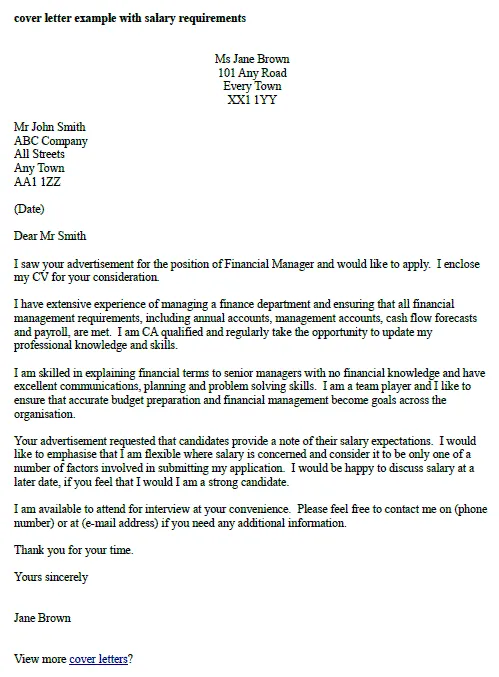
Showcase your skills and experiences that align with the job description. Provide specific examples of your accomplishments. Use quantifiable results to demonstrate your value. Tailor your examples to match the key requirements of the role. For instance, if the job requires project management skills, give a project you managed, emphasizing how you were successful. Keep the focus on your relevant experience. This section should support your salary expectations. Highlight achievements that have a direct impact on the bottom line. Consider the main responsibilities. Always relate your achievements back to the role.
Quantifying Your Achievements
Use numbers and data to demonstrate your value. Instead of saying, ‘Improved sales,’ say, ‘Increased sales by 15% in one quarter.’ Quantifiable results are more compelling. They provide concrete proof of your abilities. Always use the STAR method to detail your achievements. This includes the Situation, Task, Action, and Result. For example, in a Situation, you might explain a challenge you faced. The Task was to address it. Your Action was the steps you took. The Result was the outcome. Make your results relevant to the job description and requirements. Always use measurable achievements.
Emphasizing Your Skills and Experience
Focus on the skills and experience most relevant to the job. Read the job description carefully to identify the key requirements. Provide a few concise examples of your achievements. Explain the impact of your actions. The better you match your skills and experience to the job requirements, the better your chances. Consider all aspects of the role. Then, emphasize the skills that match. Always include hard skills and soft skills. Highlight your technical abilities. Add examples of leadership. This will show the value you can bring to the position. Make sure to stay concise and relevant.
The Call to Action
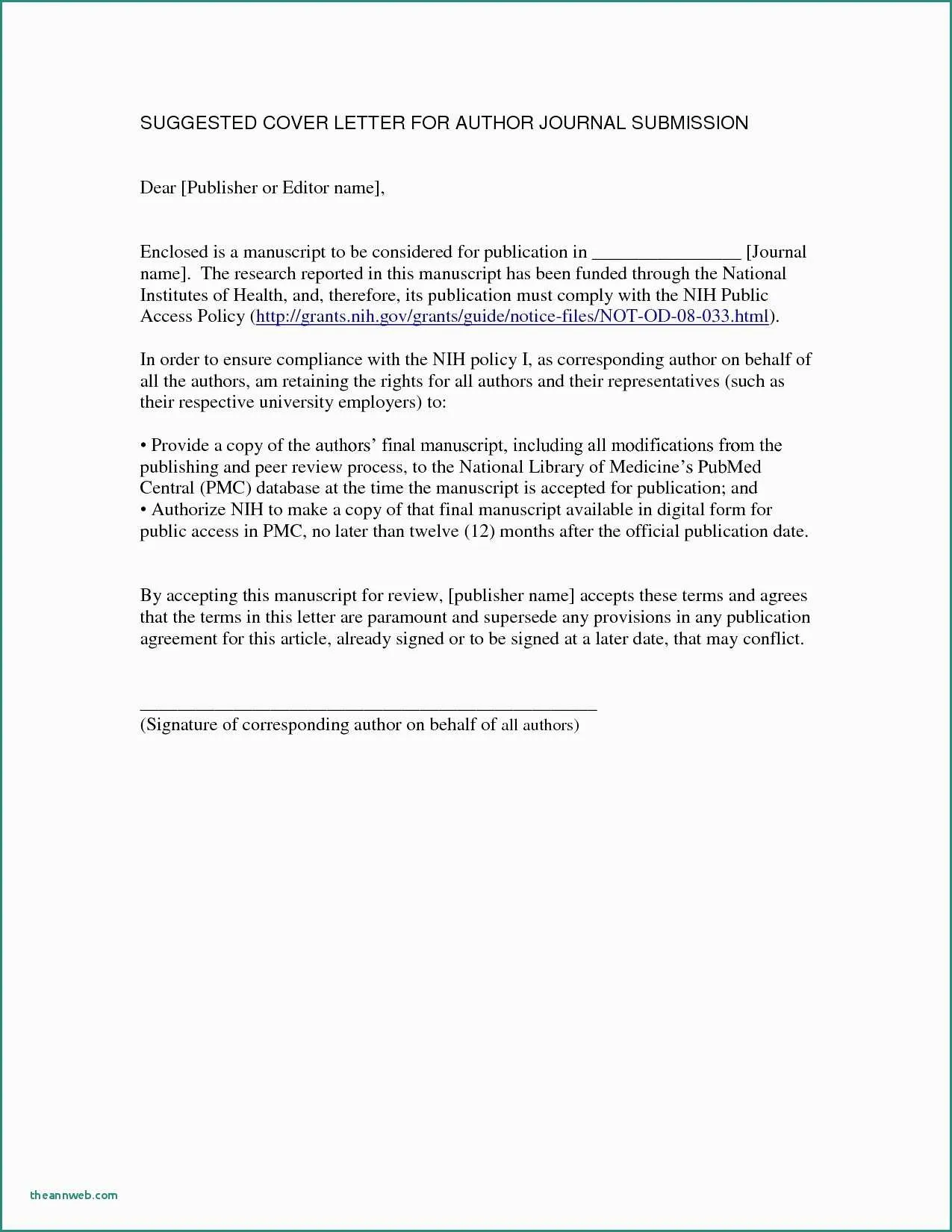
Include a clear call to action at the end of your cover letter. Request an interview or a follow-up call. Express your eagerness to discuss the position further. For example, you can state: ‘I am eager to discuss how my skills and experience can benefit your team.’ Or, you can state: ‘I am available for an interview at your earliest convenience.’ Make sure your call to action is polite and professional. Include a thank you in advance. Also, be certain to provide your contact information again. The call to action should be clear and direct.
Expressing Gratitude and Closing
Always thank the hiring manager for their time and consideration. A simple closing statement such as ‘Thank you for your time and consideration’ is appropriate. Reiterate your interest in the position. Close with a professional closing. For example, use ‘Sincerely,’ or ‘Best regards.’ Then, include your full name. Proofread everything one last time. Make sure the closing statement is polite and professional. Make sure your tone is enthusiastic and positive.
Reviewing and Editing Your Cover Letter
Before submitting your cover letter, review and edit it meticulously. Check for any grammatical errors and typos. Ensure your language is clear, concise, and professional. Verify that all the information is accurate and up-to-date. Make sure the content aligns with the job description. Read it aloud. This can help you identify awkward phrasing or areas for improvement. Ask a friend or colleague to review your letter. They may catch errors you missed. The final cover letter should be error-free and easy to read. This will help you to leave a professional impression.
Common Mistakes to Avoid
Avoid common mistakes that can undermine your cover letter. Do not include generic or overly enthusiastic language. Avoid typos. Do not use a template without customizing it. Avoid being vague about your accomplishments. Do not mention salary requirements without doing your research. Refrain from providing too much personal information. Avoid using jargon or technical terms. Make sure you are not too lengthy. Do not address the cover letter to ‘To Whom It May Concern’. Make sure you are tailoring your letter to the specific job and company. Carefully check the job posting for any instructions. Following these guidelines helps ensure your cover letter is effective.
Examples of Salary Requirement Cover Letters
Examining examples can offer valuable guidance in crafting your cover letter. When reviewing examples, focus on the structure and language used. Note how the candidate expresses their interest. Observe how they articulate their salary expectations. Pay attention to the tone of the letter. Analyze how the candidates highlight their qualifications and experience. Look for examples that match your industry and experience level. Tailor the format to suit your own background. Use these examples as inspiration. Then, create your own unique, and professional cover letter.
Entry-Level Cover Letter Example
For entry-level positions, the focus should be on education, internships, and any relevant volunteer work. The introduction should express your enthusiasm and eagerness to learn. Highlight any transferable skills you have. Show that you have a basic understanding of the industry. State your salary expectations. If you are unsure, it is acceptable to state ’negotiable’. Express your willingness to learn. Also, mention your interest in the role. Remember to tailor your resume to each job. Always be positive, enthusiastic, and professional.
Experienced Professional Cover Letter Example
For experienced professionals, showcase your achievements and quantify your results. Your introduction should immediately highlight your relevant experience. Focus on key accomplishments. Use the STAR method to describe your achievements. Provide a salary range based on your research. Explain the value you bring to the company. Always emphasize results and measurable achievements. Tailor your resume to the specific job requirements. Also, demonstrate your understanding of the company’s needs. Lastly, include a call to action and thank the hiring manager for their time.
Tips for Tailoring Your Cover Letter
Always tailor your cover letter to each job application. Read the job description carefully and identify the key requirements. Highlight the skills and experiences that match those requirements. Use the same keywords from the job posting in your letter. Tailor your cover letter to the company. Research the company and demonstrate your understanding of its values and goals. Also, customize your letter to the hiring manager. If possible, address your letter to a specific person. Review your cover letter after writing it and edit it to ensure it is customized to each job.
Formatting Your Cover Letter
Proper formatting is important for the overall presentation of your cover letter. Use a professional font like Times New Roman, Arial, or Calibri. Maintain consistent font size and style throughout the document. Use standard margins, typically one inch on all sides. Use single-spacing for the text. But use a double-space between paragraphs. Make sure your letter is easy to read. The format should be clean and professional. Keep the letter to one page. Your letter should be well-organized and easy to follow. Proofread the letter before submitting it.
Proofreading Your Cover Letter
Proofreading is a critical step in the cover letter writing process. Check for spelling errors, grammatical mistakes, and typos. Ensure your sentences are clear and concise. Read your letter aloud. This can help you to catch awkward phrasing. Ask a friend or colleague to review your letter. They can spot any mistakes. Make sure the format is consistent throughout the document. Correct any errors before submitting it. Proofreading demonstrates your attention to detail. This is critical for any job application. A well-proofread cover letter will leave a professional impression.
Submitting Your Cover Letter
When submitting your cover letter, follow the instructions. Read the job posting carefully. Adhere to any specific guidelines. Attach your cover letter and resume as separate files. Save both documents with clear file names. Use a professional email address. Make sure to include a brief, professional message in the email. Double-check your attachments before sending. Confirm you are sending it to the correct recipient. If you need to send the letter by mail, use a high-quality paper. Ensure that you are using correct addressing. Following these guidelines ensures your application is properly presented.
Following Up on Your Application
After submitting your cover letter, follow up on your application. Wait for a reasonable amount of time before following up. Send a brief email. In the email, refer to the position and express your continued interest. Reiterate your qualifications. Ask about the status of your application. Keep your follow-up email concise and professional. If you do not hear back, you may send a second follow-up email. Remember that it is alright if you do not hear back. Do not get discouraged. Follow-up emails show you are proactive. This shows your interest in the position.
What to Do After Submitting Your Cover Letter
After submitting your cover letter, continue your job search. Update and revise your cover letter. Be ready to discuss your salary expectations. Prepare for potential interviews. Practice answering common interview questions. Prepare questions to ask the interviewer. Research the company thoroughly. Be prepared to discuss your accomplishments. Reflect on your cover letter. Consider what you can improve in future applications. Use this as a learning opportunity. Job searching can be a challenging process. Don’t give up!
